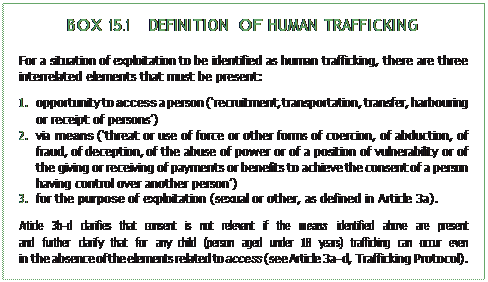 |
Human trafficking defined. Background to the development of the Protocol
|
|
|
|
HUMAN TRAFFICKING DEFINED
Human trafficking at the international level is now referred to interchangeably as ‘mod- ern day slavery’ and in some cases as ‘forced labour’. We choose not to use these terms. For clarity and consistency of meaning, we focus here on human trafficking as per the Protocol to Prevent, Suppress and Punish Trafficking in Persons, Especially Women and Children, supplementing the United Nations Convention against Transnational Organized Crime [hereinafter the Trafficking Protocol]. The Trafficking Protocol offers both a definition of human trafficking and a framework for responding. Article 2 is focused on the purpose of the Protocol. There are three key roles or intentions stated:
· To prevent and combat trafficking in persons, paying particular attention to women and children;
• To protect and assist the victims of such trafficking, with full respect for their human rights; and
• To promote cooperation among States Parties in order to meet those objectives. (UN, 2000: 2)
Human trafficking is defined in Article 3 (see also Box 15. 1):
· ‘Trafficking in persons’ shall mean the recruitment, transportation, transfer, harbouring or receipt of persons, by means of the threat or use of force or other forms of coercion, of abduction, of fraud, of deception, of the abuse of power or of a position of vulnerability or of the giving or receiving of payments or benefits to achieve the consent of a person having control over another person, for the purpose of exploitation. Exploitation shall include, at a minimum, the exploitation of the prostitution of others or other forms of sexual exploitation, forced labour or services, slavery or practices similar to slavery, servitude or the removal of organs. (Article 3, Trafficking Protocol) (UN, 2000: 3)
It is important to recognize that the Trafficking Protocol is one of three supple- mentary protocols to the Convention Against Transnational Organised Crime. All three Protocols (the other two are: The Protocol against the Smuggling of Migrants by Land, Sea and Air, and The Protocol against the Illicit Manufacturing and Trafficking in Firearms, Their Parts and Components and Ammunition) are focused on these offences as transnational crimes that necessarily involve organized crime. State’s Party to the Trafficking Protocol (those who have signed and ratified the Protocol) are required to implement legislation to criminalize trafficking and to pursue prosecutions against those who perform, participate in or organize traf- ficking offences (see Article 5). With regard to supporting victims and redressing

policy and law that might create or sustain vulnerability to exploitation, these measures are recommended or ‘encouraged’ (see Articles 9–13). The impact is that the focus and emphasis is on a criminal justice response in the first instance.
As we have outlined in detail elsewhere (Segrave et al., 2017), this means that counter-trafficking efforts have been designed around the goals of identifying victims, providing them with welfare-oriented support while an investigation takes place, with a view to determining which cases can be prosecuted. We and others have argued that there are significant consequences for responding to human trafficking as a law and order issue, in which the priority is on prosecution and punishment of traffickers (see Anderson and Andrijasevic, 2008; Milivojevic and Segrave, 2012). Our main concern is that the consequence of such an approach is the focus on prosecutions as an ‘out- come’; however, we argue, there is no direct impact from prosecutions on the broader practice of exploitation. While the US Trafficking in Persons report [TIP report] pro- duces data on prosecution statistics related to human trafficking, as researchers we understand that laws in every country are different and such data tells us very little. Instead, we need to ask how ‘success’ is defined, and how we can measure ‘effective- ness’ and ‘impact’. We identify some ways to achieve this below.
|
|
|
Background to the development of the Protocol
It has been well canvassed by various authors (see Doezema, 2005; Outshoorn, 2015) that what underpinned the development of the Protocol was a specific concern around sex trafficking, which was heavily influenced by the ongoing debate between feminist activists regarding prostitution as violence against women versus advocates for sex
work as a legitimate form of labour. We recommend reading further into this, not least because it offers an explanation for the division, particularly in the first decade of human trafficking research and counter-trafficking strategies that focused almost exclu- sively on sex trafficking. We are researchers who recognize migrant sex workers as labourers, and who adopt a critical approach to the gendered moralizing that occurred in the early responses to sex trafficking (for more, see Segrave et al., 2009).
|
|
|


